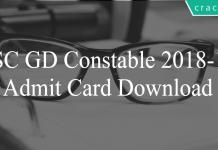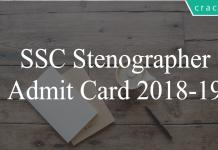SSC CGL Arithmetic Questions
Download SSC CGL Arithmetic questions with answers PDF based on previous papers very useful for SSC CGL exams. 25 Very important Arithmetic objective questions for SSC exams.
Download SSC CGL Arithmetic Questions
Question 1: What is the value of $462.767-241\div7\times3+134.568 $
a) 497.345
b) 494.050
c) 498.389
d) 499.987
Question 2: What is the value of $1225\div5+400\times3.2-312 $
a) 1213
b) 1211
c) 1209
d) 1208
Question 3: $77 + 78 + 79 + ……… +113$ is equal to
a) 3215
b) 3615
c) 3415
d) 3515
Question 4: Find the 13th term, if the 3rd term of an arithmetic progression is 1, 9th term is 25?
a) 49
b) 37
c) 45
d) 41
Question 5: Reduce fraction $\large\frac{13167}{19019}$ into lowest terms.
a) $\large\frac{7}{13}$
b) $\large\frac{9}{13}$
c) $\large\frac{19}{13}$
d) $\large\frac{11}{13}$
SSC CGL Previous Papers Download PDF
Question 6: 45 is 1.8% of?
a) 2500
b) 2900
c) 2800
d) 2400
Question 7: Reduce fraction $\large\frac{2275}{2457}$ into lowest terms.
a) $\large\frac{25}{29}$
b) $\large\frac{21}{27}$
c) $\large\frac{24}{27}$
d) $\large\frac{25}{27}$
Question 8: Find the fourth term of the sequence for which $t_{1}=2$, $t_{2}=3$ and $t_{n+2}$ = $t_{n}+2t_{n+1}$, is
a) 17
b) 19
c) 12
d) 13
Question 9: If $\ p^{2}+16q^{2}\ = 8pq$, then $p: q$ is
a) 4: 1
b) 4: 3
c) 4: 5
d) 2: 3
Question 10: $7\Large\frac{1}{3}$ $+$ $5\Large\frac{1}{4}$ $-$ $8\Large\frac{3}{5}$ $+$ $15\Large\frac{2}{7}$ $=$?
a) $19\large\frac{321}{420}$
b) $19\large\frac{231}{420}$
c) $19\large\frac{113}{420}$
d) $17\large\frac{221}{420}$
18000+ Questions – Free SSC Study Material
Question 11: $7\Large\frac{1}{5}$ $+$ $2\Large\frac{1}{3}$ $-$ $4\Large\frac{2}{15}$ $-$ $3\Large\frac{5}{18}$ $+$ $5\Large\frac{2}{9}$ $=$?
a) $5\large\frac{35}{78}$
b) $7\large\frac{31}{90}$
c) $9\large\frac{36}{73}$
d) $4\large\frac{37}{79}$
e) None of these
Question 12: $\Large\frac{628}{60}$ $-$ $\Large\frac{44}{45}\div\frac{6}{9}$ $+$ $\Large\frac{575}{624}\div\frac{25}{104}$ $+$ $\Large\frac{13}{15}\div\frac{2}{5}$ $=$ $\large?$
a) 15
b) 25
c) 10
d) 14
e) None of these
Question 13: $15.921$ $+$ $9.679$ $+$ $101.36$ $-$ $94.76$ $=$ $17.976$ $+$ $6.224$ $+$ ?
a) 7
b) 5
c) 8
d) 9
e) None of these
Question 14: $\sqrt{1936}\div\sqrt[3]{1331}\times\sqrt{50625}\div\sqrt{14400}\times\sqrt{64}$ $=$ $7920\div132$ $+$ ?
a) 1
b) -3
c) 0
d) -1
e) None of these
Question 15: $522\div150\times25$ $+$ $96\div180\times15$ $-$ $\Large\frac{1125}{135}$ $\div$ $\Large\frac{5}{9}$ $=$ ?
a) 80
b) 75
c) 105
d) 65
e) None of these
Question 16: What would come in place of ($) mark in the following equation ?
* 2 $ 20 ÷ 156 = 145
a) 6
b) 2
c) 4
d) 0
Question 17: If $\ x^{2}+9y^{2}\ $= 6xy, then x: y is
a) 1 : 3
b) 3 : 2
c) 3 : 1
d) 2 : 3
Question 18: Three circles of radius 21 cm are placed in such a way that each circle touches the other two. What is the area of the portion enclosed by the three circles?
a) $441{3} – 693$
b) $882\sqrt{3} – 693$
c) $882\sqrt{3} – 462$
d) $441\sqrt{3} – 462$
Question 19: In a class, there are 40 students. Some of them passed the examination and others failed. Raman’s rank among the student who have passed is 13 th from top and 17 th from bottom. How many students have failed?
a) 11
b) 10
c) 9
d) Cannot be determined
Question 20: By interchanging which two signs the equation will be correct?
25 + 18 ÷ 2 – 4 = 20
a) + and ÷
b) + and –
c) ÷ and –
d) None of these
100+ Free GK Tests for SSC Exams
Answers & Solutions:
1) Answer (B)
by applying BODMAS we have
=462.767-(34.428*3)+134.568
=462.767-103.285+134.568
=494.05
2) Answer (A)
by applying BODMAS we have
=245+1280-312
=1525-312
=1213
3) Answer (D)
Expression : $77 + 78 + 79 + ……… +113$
This is an arithmetic progression with first term, $a = 77$ , last term, $l = 113$ and common difference, $d = 1$
Let number of terms = $n$
Last term in an A.P. = $a + (n – 1)d = 113$
=> $77 + (n – 1)(1) = 113$
=> $n – 1 = 113 – 77 = 36$
=> $n = 36 + 1 = 37$
$\therefore$ Sum of A.P. = $\frac{37}{2} (a + l)$
= $\frac{37}{2} (77 + 113)$
= $95 \times 37 = 3515$
4) Answer (D)
The $n^{th}$ term of an A.P. = $a + (n – 1) d$, where ‘a’ is the first term , ‘n’ is the number of terms and ‘d’ is the common difference.
3rd term, $A_3 = a + (3 – 1) d = 1$
=> $a + 2d = 1$ —————–(i)
Similarly, 9th term, $A_{9} = a + 8d = 25$ ——————(ii)
Subtracting equation (i) from (ii), we get :
=> $(8d – 2d) = 25 – 1$
=> $d = \frac{24}{6} = 4$
Substituting it in equation (i), => $a + 8 = 1$
=> $a = 1 – 8 = -7$
$\therefore$ 13th term, $A_{13} = a + (13 – 1)d$
= $-7 + (12 \times 4) = -7+48 = 41$
=> Ans – (D)
5) Answer (B)
Given, Expression : $\frac{13167}{19019}$
We need to check whether any of the prime factors from 2, 3, 5, 7, 11, 13, 17, 19…… divides both numerator & denominator.
We observe that they can be divided by 7, 11 & 19.
Dividing both numerator and denominator by 7, we get = $\frac{1881}{2717}$
Similarly, dividing by 11, we get :
= $\large\frac{171}{247}$
Similarly, dividing by 19, we get :
= $\large\frac{9}{13}$
=> Ans – (B)
6) Answer (A)
Let the number be $n$
According to ques, 1.8% of $n$ = 45
=> $\frac{1.8}{100} \times n = 45$
=> $\frac{1.8n}{100} = 45$
=> $n = \large\frac{45 \times 100}{1.8}$ $ = 2500$
=> Ans – (A)
7) Answer (D)
Given Expression : $\large\frac{2275}{2457}$
We need to check whether any of the prime factors from 2, 3, 5, 7, 11, 13, 17, 19…… divides both numerator & denominator.
We observe that they can be divided by 7, 13.
Dividing both numerator and denominator by 13, we get = $\frac{175}{189}$
Similarly, dividing by 7, we get :
= $\frac{25}{27}$
=> Ans – (D)
8) Answer (B)
Given, $t_{1}=2$, $t_{2}=3$
$t_{n+2}$ = $t_{n}+2t_{n+1}$
putting n=2, we get the 4th term. therefore, $t_{4}$ = $t_{2}+2t_{3}$
So,we need to find, $t_{3}$
$t_{3}$ = $t_{1}+2t_{2}$ = 2+2(3) = 8
$t_{4}$ = $t_{2}+2t_{3}$ = 3+2(8) = 19
so the answer is option B.
9) Answer (A)
Given, $\ p^{2}+16q^{2}\ = 8pq$
$p^{2}+16q^{2}=6pq$
$\Rightarrow p^{2}-8pq+16q^{2}=0$
$\Rightarrow (p-4q)^{2}=0$
$\Rightarrow p-4q=0$
$\Rightarrow p=4q$
$\Rightarrow \frac{p}{q}$=$\frac{4}{1}$
$\therefore p: q=4: 1$
10) Answer (C)
Given, $7\Large\frac{1}{3}$ $+$ $5\Large\frac{1}{4}$ $-$ $8\Large\frac{3}{5}$ $+$ $15\Large\frac{2}{7}$ $=$?
= 7+5-8+15+$\large\frac{1}{3}+\frac{1}{4}-\frac{3}{5}+\frac{2}{7}$
=19+ $\large\frac{140+105-252+120}{420}$
= 19$\large\frac{113}{420}$
11) Answer (B)
7$\frac{1}{5}$+2$\frac{1}{3}$-4$\frac{2}{15}$-3$\frac{5}{18}$+5$\frac{2}{9}$
= 7+2-4-3+5+$\frac{1}{5}$+$\frac{1}{3}$-$\frac{2}{15}$-$\frac{5}{18}$+$\frac{2}{9}$
=7+ $\frac{18+30-12-25+20}{90}$
= 7$\frac{31}{90}$
12) Answer (A)
$\Large\frac{628}{60}$ $-$ $\Large\frac{44}{45}\div\frac{6}{9}$ $+$ $\Large\frac{575}{624}\div\frac{25}{104}$ $+$ $\Large\frac{13}{15}\div\frac{2}{5}$
$=$ $\Large\frac{314}{30}$ $-$ $\Large\frac{44}{30}$ $+$ $\Large\frac{115}{30}$ $+$ $\Large\frac{65}{30}$
$=$ $\Large\frac{450}{30}$ $=15$
13) Answer (C)
$15.921$ $+$ $9.679$ $+$ $101.36$ $-$ $94.76$ $-$ $17.976$ $-$ $6.224$ $=$ ?
Adding all Positive terms:
$15.921$ $+$ $9.679$ $+$ $101.36$ $=$ $126.96$
Adding all Negative terms:
$94.76$ $+$ $17.976$ $+$ $6.224$ $=$ $118.96$
$126.96$ $-$ $118.96$ $=$ $8$
14) Answer (C)
$\large\sqrt{1936}\div\sqrt[3]{1331}\times\sqrt{50625}\div\sqrt{14400}\times\sqrt{64}$ $-$ $\large7920\div132$ $=$ ?
$\Large\frac{44}{11}$ $\times$ $\Large\frac{225}{(\Large\frac{120}{8})}$ $-$ $\Large\frac{7920}{132}$
$4$ $\times$ $15$ $-$ $60$ $=$ $0$
15) Answer (A)
$522\div150\times25$ $=$ $87$
$96\div180\times15$ $=$ $8$
$\Large\frac{1125}{135}$ $\div$ $\Large\frac{5}{9}$ $=$ $15$
$87$ $+$ $8$ $-$ $15$ $=$ $80$
16) Answer (A)
17) Answer (C)
$x^{2}+9y^{2}$=6xy
$\Rightarrow x^{2}-6xy+9y^{2}$=0
$\Rightarrow (x-3y)^{2}$=0
$\Rightarrow$ x-3y=0
$\Rightarrow$ x=3y
$\Rightarrow \frac{x}{y}$=$\frac{3}{1}$
$\therefore$ x:y=3:1
18) Answer (A)
Radius of each circle = $r=21$ cm
=> AC = $r+r=42$ cm
Similarly, AB = 42 cm and BC = 42 cm
=> $\triangle$ ABC is an equilateral triangle having $\angle A=\angle B=\angle C=60^\circ$
Thus, area of shaded portion = (Area of $\triangle$ ABC) – ($3\times$ Area of each sector)
= $(\frac{\sqrt3}{4}\times s^2)-(3\times\frac{\theta}{360^\circ}\times\pi r^2)$
= $(\frac{\sqrt3}{4}\times 42\times42)-(3\times\frac{60^\circ}{360^\circ}\times\frac{22}{7}\times21\times21)$
= $(441\sqrt3)-(11\times3\times21)$
= $(441\sqrt3-693)$ $cm^2$
=> Ans – (A)
19) Answer (A)
Total number of students = 40
Among the student who have passed, Raman’s rank from top = 13th
Raman’s rank from bottom = 17th
=> Total students who passed = $(13+17)-1=30-1=29$
$\therefore$ Number of students who have failed = $40-29=11$
=> Ans – (A)
20) Answer (B)
Expression : 25 + 18 ÷ 2 – 4 = 20
(A) : + and ÷
$\equiv25\div18+2-4=20$
L.H.S. = $1.39-2=-0.61\neq20$
(B) : + and –
$\equiv25-18\div2+4=20$
L.H.S. = $25-9+4=20$
=> Ans – (B)





